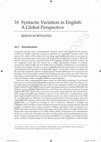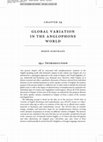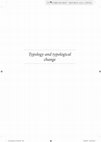Book chapters by Bernd Kortmann

Oxford Research Encyclopedia of Linguistics, 2024
English is by far the most widely spoken Germanic language, with approximately 400 million native... more English is by far the most widely spoken Germanic language, with approximately 400 million native speakers, another 500 million L2 speakers, and at least a billion of moderately competent speakers of English as a Foreign Language. In close to 60 countries, English enjoys official status or is one of the native languages. With several fully codified standard varieties used in different nation-states, English also qualifies as the most pluricentric of the Germanic languages. British and American English are still the most powerful norm-providing Standard Englishes worldwide and the leading target models in the international classroom of English as a second or foreign language. Many of the changes in their grammars in the course of the 20th century happened independently of each other. In American English, such changes typically started earlier, spread faster, and affected more words or structures compared with British English.
English is the most innovative of all Germanic languages when looking at its evolution since early medieval times, closely followed by the Mainland Scandinavian languages. Despite the fact that English and German both belong to the West Germanic branch, it is between these two languages that the greatest Germanic-internal typological distance holds, with German being placed at the pole of the structurally most conservative West Germanic language and (along with Icelandic) of all Germanic languages. English is highly analytic and exhibits many properties typically found in SVO languages, whereas German is still highly synthetic and shows many more typical properties of an SOV language.
Mobility, migration, and language and dialect contact have played crucial roles in the history and development of English right from inception in the early Middle Ages. The extent to which the multiple language contact situations in the history of English have shaped the language, especially its grammar, is still a matter of debate. What is a fact is that the major typological changes of the English language away from the highly synthetic language type of Old Germanic happened exactly in the late Old English and, above all, the Middle English periods. Early Modern English was primarily a period of standardization, the Great Vowel Shift, and a heavy extension of the vocabulary because of its massive borrowing from Latin and French. The main characteristics of Late Modern English are continuity, stability, and norm-oriented codification of the English language via dictionaries and grammars. Both modern periods, especially the 18th and the 19th centuries, saw the global spread of English in the wake of colonial expansion, laying the foundations to English becoming a true world language with many varieties in different parts of the world.
Mehr Mut wagen! Plädoyer für eine aktive Politik und Gesellschaft, 2024
This volume offers a plea for more courage in politics and society, in times of crisis as well as... more This volume offers a plea for more courage in politics and society, in times of crisis as well as in everyday life! How to take bolder, more courageous decisions in order to master conflicts and crises, big and small, in politics and society in the challenging 2020s. In 11 essays, facets and prerequisites of (more) courage, along with concrete examples and case studies, are discussed by both practitioners and researchers in the domains of politics, journalism, economics, philosophy, psychology, and legal studies.
Jenseits von Corona, 2020
oe®¨OEoeÈË®-oeOE `OE¨È ®vƒš ³À³®v OEÀ®ˆ 3³ÀÈ-v®® Ë®ˆ %ήȚOEÀ % OƒšË¨çOE G d über 200.000 Bewohne... more oe®¨OEoeÈË®-oeOE `OE¨È ®vƒš ³À³®v OEÀ®ˆ 3³ÀÈ-v®® Ë®ˆ %ήȚOEÀ % OƒšË¨çOE G d über 200.000 Bewohner Deutschlands mit dem Coronavirus in ziert, F d größte Rezession in der deutschen Nachkriegsgeschichte mit einem Einbruch des Bruttoinlandsprodukts um 6,5 Prozent erwartet. Vielfa che tiefgreifende Beschränkungen haben unser Leben seit März dieses Jahres geprägt, wirtscha tliche Existenzen bedroht oder vernichtet,
A Handbook of Varieties of English, 2004

Language Complexity as an Evolving Variable, 2009
In this paper we will report on recent and ongoing research on large-scale morphosyntactic variat... more In this paper we will report on recent and ongoing research on large-scale morphosyntactic variation in non-standard varieties of English. Our empirical basis will be what may be called the 'World Atlas of Morphosyntactic Variation in English', which is an outgrowth of the largest comparative study (Kortmann and Szmrecsanyi 2004) to date of entire grammatical subsystems of varieties of English worldwide. A catalogue of 76 morphosyntactic features taken from 11 core areas of English morphosyntax was investigated for 46 (groups of) non-standard varieties of English around the world, including 20 L1 varieties, 11 L2 varieties, and 15 Pidgins and Creoles from all seven anglophone world regions (the British Isles, the Americas, the Caribbean, the Pacific Archipelagos, Australasia, Africa, South and Southeast Asia). We will show that the varieties of English can be thought of as varying along two major morphosyntactic dimensions: analyticity and complexity. We will discuss this variance, along with Greenbergian-type indices of inflectional complexity (Greenberg 1960) derived from naturalistic corpus data, in light of (a) the various complexity notions currently debated in the literature (notably Dahl 2004, McWhorter 2001, Hawkins 2004), and (b) Trudgill's suggestion (forthcoming) that in varieties of English simplification is to be found in high-contact varieties while complexification is characteristic of low-contact varieties, i.e., traditional L1 dialects in the British Isles and North America.

Handbook of English Linguistics, 2nd edition, 2021
Compared with the study of phonological variation, much less is known about syntactic variation i... more Compared with the study of phonological variation, much less is known about syntactic variation in English, especially among non-standard (or vernacular) varieties, which will stand at the center of this chapter. For one thing, significantly more data are necessary to identify interesting instances and, above all, larger patterns of syntactic variation. Many differences between varieties, especially between the national (written) standard varieties, are not categorical (such that one variety has a certain grammatical element or syntactic construction which another has not). Rather the vast majority of differences are quantitative in nature (see Chapter 14), that is, a given construction may be preferred in one variety but used distinctly less frequently in another. Only once a critical mass of data is available can the semantic/pragmatic patterns underlying such marked differences in text frequency be identified. For non-standard varieties, much progress has been made since 2005, when the first edition of this handbook was prepared. And still we are only at the beginning of largescale quantitative studies using the toolkit of corpus linguistics. Since the 1990s, computerized corpora (based on transcribed recordings of oral history interviews or conversations among dialect speakers from the 1970s or later) have been or are currently being compiled for a growing number of non-standard varieties (e.g., the Freiburg English Dialect Corpus (FRED) with its newly developed interactive interface FREDDIE, the Helsinki Corpus of British English Dialects, or the Diachronic Electronic Corpus of Tyneside English (DECTE) 1), even if they cannot rival in size the megacorpora for the national standard varieties of English (see Chapters 4 and 14). At the same time, we simply know much more about syntactic variation in non-standard varieties now than we did in the early 1980s (cf., e.g., Edwards et al. 1984) due to a much-increased number of relevant studies, especially in the 2000s. The majority of these deal with individual phenomena in individual dialects or dialect areas, as compiled for example in such a milestone collection as Trudgill and Chambers (1991), but there are also excellent structural surveys for regional and non-regional varieties of English, such as those provided in
Oxford Bibliographies in Linguistics, 2020
English Linguistics: Essentials, 2020

English Linguistics: Essentials, 2020
Morphology is concerned with the internal structure of words and with the various processes which... more Morphology is concerned with the internal structure of words and with the various processes which allow us to constantly expand the vocabulary of a language. Morpheme: The basic morphological unit is not the word, but the morpheme (Greek morphé = shape, form), the smallest meaning-bearing unit of language. Thus, the word singers contains three morphemes: sing,-er, and-s. Each of these three morphemes adds to the overall meaning of singers: the verb sing makes the central contribution, while-er on its own means no more than 'someone who VERBs', and the-s merely gives grammatical information, namely plural. This simple example shows that we can distinguish between different types of morphemes. It is a widespread convention in linguistics to put morphemes in curly brackets, e. g. {SING}, {Plural}; however, most of the time this convention can be dispensed with without a loss of clarity. Morphemes vs (allo-)morphs: On the level of morphology, morphemes are the exact counterpart to phonemes on the level of phonology. Just like phonemes, morphemes are abstract units which can be realized by more than one form. Just think of the plural morpheme in word forms like kids, kits, and kisses, where it is realized as /-z/, /-s/, and /-ɪz/ respectively. These concrete realizations of morphemes are called morphs, and in analogy to the allophones of a phoneme we speak of the allomorphs of a morpheme (more on this in section 3.2). Word-word form-lexeme: The example singers also serves to show how important it is to deal with the term word in a more differentiated way. Is singers a different word from singer? No, singers is merely a different form, a so-called word form, of the noun singer. Singer itself, on the other hand, is not merely a word form of sing, but a different, new word, which has been formed by affixation of-er to the verb. In this case, we speak of a new lexeme with a new dictionary entry which has been created by a specific derivational process. And what about sing itself: is it a word, a lexeme, or a morpheme? Three times yes: sing is a morpheme that can occur on its own (a socalled free morpheme); it denotes something in the extra-linguistic, i. e. real world, in this case a particular action or activity; it has an entry in the dictionary, and thus qualifies as a lexeme; and it is a word, if we adopt the prototypical use of word in everyday language. The example sing furthermore shows that words do not necessarily have an internal structure: it merely consists of one morpheme. The fact that sing, besides being definitions morphological structure ≠ syllable structure 3.1 Types of morphemes 3.2 Morphophonemics: Interface of morphology and phonology 3.3 Word formation processes
English Linguistics: Essentials, 2020
English Linguistics: Essentials, 2020
Semantics (Greek semain-= to mean) is the only branch of linguistics which is exclusively concern... more Semantics (Greek semain-= to mean) is the only branch of linguistics which is exclusively concerned with meaning. Semantics studies the meaning or meaning potential of various kinds of expressions: words, phrases, and sentences. This chapter is mainly confined to the study of word meaning (lexical semantics; lexicology). Research in lexical semantics addresses the following questions: ■ How can the concept of meaning be elucidated, including the relation between meaning and external reality? ■ What are appropriate tools for analysing and describing meanings? ■ What kinds of semantic structures exist within the vocabulary (or: lexicon) of a language?
English Linguistics: Essentials, 2020

Oxford Handbook of English Grammar, 2019
Based on the data set in the electronic World Atlas of Varieties of English, the primary purpose ... more Based on the data set in the electronic World Atlas of Varieties of English, the primary purpose of this chapter is to determine the areal and global reach as well as the degree of distinctiveness of morphosyntactic properties for fifty spontaneous spoken L1 and L2 Englishes as well as twenty-six English-based pidgins and creoles spoken in seven Anglophone world regions (Africa, North America, Australia, British Isles, the Caribbean, the Pacific, South and Southeast Asia). Central questions addressed include the following: Which are the most widespread non-standard morphosyntactic features in the Anglophone world? Are there distinctive, or even diagnostic, features for the different variety types? Is it possible to identify systematic correlations between variety type and different degrees of structural complexity? Which are the most widespread or even diagnostic features for the different parts of the English-speaking world?
The Cambridge Handbook of Areal Linguistics, 2017
2. Top diagnostic features in morphosyntax for individual Anglophone world regions 3. Synopsis: A... more 2. Top diagnostic features in morphosyntax for individual Anglophone world regions 3. Synopsis: Areality in the Anglophone world 4. Smaller-scale areal patterns within selected world regions 5. Conclusion Irish E (IrE), Welsh E (WelE), Manx E (ManxE), Channel Islands E (ChlsE) [Maltese E (MltE)] British Creole (BrC) Africa (17): Liberian Settler E (LibSE), White South African E (WhSAfE), White Zimbabwean E (WhZimE), Cape Flats English (CFE)
Frontiers in psychology, 2017
World Englishes, 2016
The question how substrate features and extralinguistic conditions interact in shaping contact va... more The question how substrate features and extralinguistic conditions interact in shaping contact varieties is an ongoing debate in the study of world Englishes. The present study tries to describe substrate influence by identifying an areally marked morphosyntactic feature, subject pronoun deletion, and comparing its occurrence and structural conditioning in two closely related varieties of English in Southeast Asia. Our results show that even in the typologically similar linguistic habitats of Hong Kong and Singapore, the different degrees of nativisation are reflected in the frequency and distribution of null subjects in the two relevant local varieties.
Space in Language and Linguistics: Geographical, Interactional, and Cognitive Perspectives, 2013
Sprachwissenschaft: Grammatik - Interaktion - Kognition. , 2013
Jeder, der in seinem Leben eine Fremdsprache gelernt hat — und sei es nur eine eng mit dem Deutsc... more Jeder, der in seinem Leben eine Fremdsprache gelernt hat — und sei es nur eine eng mit dem Deutschen verwandte wie das Englische —, hat dadurch einen kleinen Einblick darin erhalten, wie unterschiedlich Sprachen sein konnen. In der Welt werden heute 6000 bis 7000 Sprachen aus ganz unterschiedlichen Sprachfamilien gesprochen. Eine wichtige Aufgabe der Sprachwissenschaft ist es, diese Sprachen sorgfaltig zu dokumentieren und die Unterschiede und Gemeinsamkeiten zwischen ihnen wissenschaftlich zu beschreiben. Den linguistischen Datenbestand der Welt zu sichern ist schon deshalb wichtig, weil viele Sprachen akut vom Aussterben bedroht sind. Laut Schatzungen stirbt derzeit etwa alle zwei Wochen mit ihrer letzten Sprecherin oder ihrem letzten Sprecher eine Sprache aus.

The Oxford Handbook of the History of English, 2012
This article explores various ways in which established and recent theories, concepts and methods... more This article explores various ways in which established and recent theories, concepts and methods in language typology are, or can be, relevant for investigating language change in general and the history of English(es) in particular. It considers the ways that the study of the history of the English language may benefit from a modern typologist’s take on language variation and change. Language typology can be used in at least four different ways to rethink the history of English and English historical linguistics: in light of (pervasive) cross-linguistic tendencies; in light of larger patterns or correlations among structural changes; in light of the major branches of diachronic typology, especially diachronic word order typology and grammaticalization; and in light of recent theories and especially (quantitative) methods in language typology. Another factor involved in this rethinking process is dialectology.
Historical Linguistics of English: An International Handbook, 2012
This chapter provides an outline of the major patterns of variation in contemporary British Engli... more This chapter provides an outline of the major patterns of variation in contemporary British English on both the phonological (Section 2) and the morpho-syntactic level (Section 3). In Section 2 it will be shown that although rich patterns of variation exist on the consonant system, these are mainly a function of socioeconomic factors as well as speech style rather than regional distribution. On the other hand, major regional stratifications are found in the vowel system. On the morpho-syntactic level we can differentiate between pan-British features (outlined in Section 3.1) and regional features (Section 3.2). It will be shown that the major North-South distinction that holds in terms of the phonology of British English is also reflected in the morpho-syntactic data.











Uploads
Book chapters by Bernd Kortmann
English is the most innovative of all Germanic languages when looking at its evolution since early medieval times, closely followed by the Mainland Scandinavian languages. Despite the fact that English and German both belong to the West Germanic branch, it is between these two languages that the greatest Germanic-internal typological distance holds, with German being placed at the pole of the structurally most conservative West Germanic language and (along with Icelandic) of all Germanic languages. English is highly analytic and exhibits many properties typically found in SVO languages, whereas German is still highly synthetic and shows many more typical properties of an SOV language.
Mobility, migration, and language and dialect contact have played crucial roles in the history and development of English right from inception in the early Middle Ages. The extent to which the multiple language contact situations in the history of English have shaped the language, especially its grammar, is still a matter of debate. What is a fact is that the major typological changes of the English language away from the highly synthetic language type of Old Germanic happened exactly in the late Old English and, above all, the Middle English periods. Early Modern English was primarily a period of standardization, the Great Vowel Shift, and a heavy extension of the vocabulary because of its massive borrowing from Latin and French. The main characteristics of Late Modern English are continuity, stability, and norm-oriented codification of the English language via dictionaries and grammars. Both modern periods, especially the 18th and the 19th centuries, saw the global spread of English in the wake of colonial expansion, laying the foundations to English becoming a true world language with many varieties in different parts of the world.
English is the most innovative of all Germanic languages when looking at its evolution since early medieval times, closely followed by the Mainland Scandinavian languages. Despite the fact that English and German both belong to the West Germanic branch, it is between these two languages that the greatest Germanic-internal typological distance holds, with German being placed at the pole of the structurally most conservative West Germanic language and (along with Icelandic) of all Germanic languages. English is highly analytic and exhibits many properties typically found in SVO languages, whereas German is still highly synthetic and shows many more typical properties of an SOV language.
Mobility, migration, and language and dialect contact have played crucial roles in the history and development of English right from inception in the early Middle Ages. The extent to which the multiple language contact situations in the history of English have shaped the language, especially its grammar, is still a matter of debate. What is a fact is that the major typological changes of the English language away from the highly synthetic language type of Old Germanic happened exactly in the late Old English and, above all, the Middle English periods. Early Modern English was primarily a period of standardization, the Great Vowel Shift, and a heavy extension of the vocabulary because of its massive borrowing from Latin and French. The main characteristics of Late Modern English are continuity, stability, and norm-oriented codification of the English language via dictionaries and grammars. Both modern periods, especially the 18th and the 19th centuries, saw the global spread of English in the wake of colonial expansion, laying the foundations to English becoming a true world language with many varieties in different parts of the world.
WAVE is unique in its coverage of variation in English: The number of grammatical features and the number of varieties covered exceeds those treated in any previous publication on the topic.
The Atlas serves as an indispensable research tool for specialists in many different fields of linguistics, including creolistics, dialectology, dialect syntax, language change, language typology, sociolinguistics, second language acquisition, the study of World Englishes and learner Englishes.
The Atlas offers perspectivizing accounts of the 74 data sets as well as large-scale comparisons across the individual variety types and Anglophone world regions.
Very attractive combination with the open access resource eWAVE: extensive supplementary materials are available at www.ewave-atlas.org